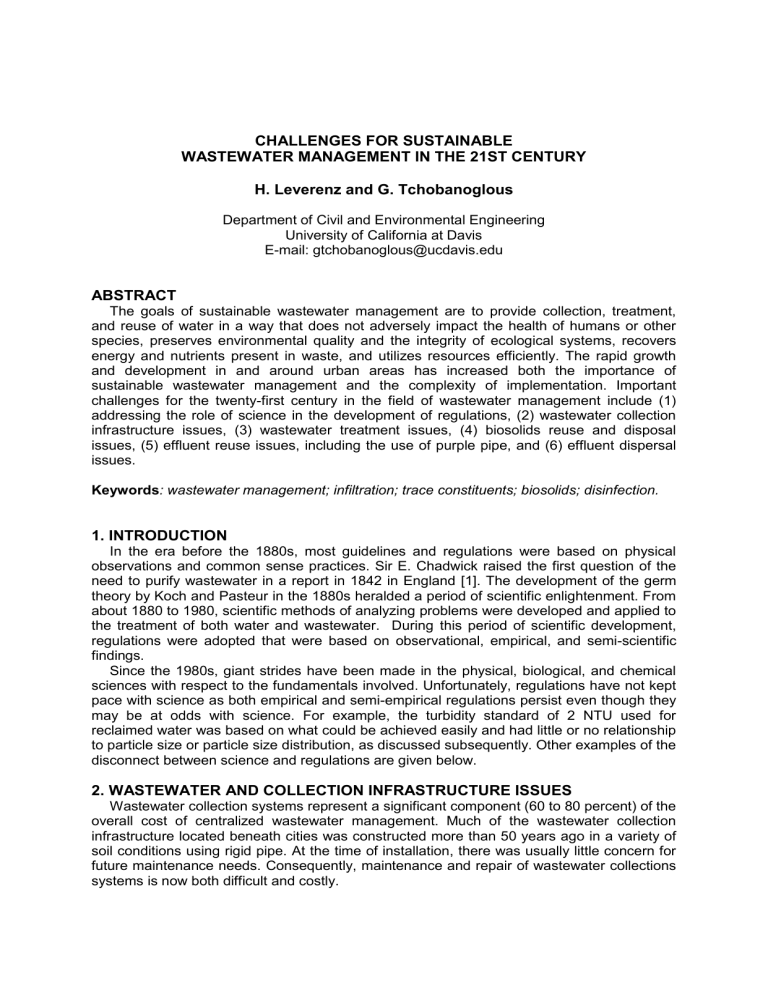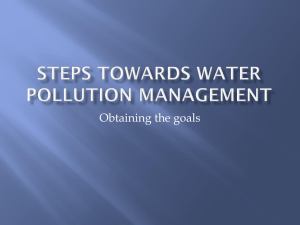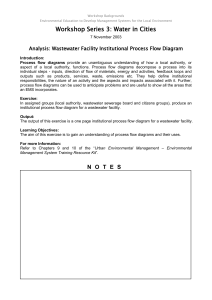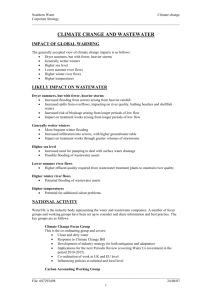CHALLENGES FOR SUSTAINABLE WASTEWATER

CHALLENGES FOR SUSTAINABLE
WASTEWATER MANAGEMENT IN THE 21ST CENTURY
H. Leverenz and G. Tchobanoglous
Department of Civil and Environmental Engineering
University of California at Davis
E-mail: gtchobanoglous@ucdavis.edu
ABSTRACT
The goals of sustainable wastewater management are to provide collection, treatment, and reuse of water in a way that does not adversely impact the health of humans or other species, preserves environmental quality and the integrity of ecological systems, recovers energy and nutrients present in waste, and utilizes resources efficiently. The rapid growth and development in and around urban areas has increased both the importance of sustainable wastewater management and the complexity of implementation. Important challenges for the twenty-first century in the field of wastewater management include (1) addressing the role of science in the development of regulations, (2) wastewater collection infrastructure issues, (3) wastewater treatment issues, (4) biosolids reuse and disposal issues, (5) effluent reuse issues, including the use of purple pipe, and (6) effluent dispersal issues.
Keywords: wastewater management; infiltration; trace constituents; biosolids; disinfection.
1. INTRODUCTION
In the era before the 1880s, most guidelines and regulations were based on physical observations and common sense practices. Sir E. Chadwick raised the first question of the need to purify wastewater in a report in 1842 in England [1]. The development of the germ theory by Koch and Pasteur in the 1880s heralded a period of scientific enlightenment. From about 1880 to 1980, scientific methods of analyzing problems were developed and applied to the treatment of both water and wastewater. During this period of scientific development, regulations were adopted that were based on observational, empirical, and semi-scientific findings.
Since the 1980s, giant strides have been made in the physical, biological, and chemical sciences with respect to the fundamentals involved. Unfortunately, regulations have not kept pace with science as both empirical and semi-empirical regulations persist even though they may be at odds with science. For example, the turbidity standard of 2 NTU used for reclaimed water was based on what could be achieved easily and had little or no relationship to particle size or particle size distribution, as discussed subsequently. Other examples of the disconnect between science and regulations are given below.
2. WASTEWATER AND COLLECTION INFRASTRUCTURE ISSUES
Wastewater collection systems represent a significant component (60 to 80 percent) of the overall cost of centralized wastewater management. Much of the wastewater collection infrastructure located beneath cities was constructed more than 50 years ago in a variety of soil conditions using rigid pipe. At the time of installation, there was usually little concern for future maintenance needs. Consequently, maintenance and repair of wastewater collections systems is now both difficult and costly.
2.1. Cost for Rehabilitation of Aging Infrastructure
As wastewater collection systems age, a number of problems and failures develop, including, cracking, collapse, and clogging. The U.S. EPA [2] has estimated that the repair bill for correcting sanitary sewer overflows (SSOs) is on the order of $90 billion and the corresponding bill for combined (sanitary plus stormwater) sewer overflows (CSOs) is $60 billion. An important question that must be answered is how should the expenditures for the needed repairs and rehabilitation be prioritized? If the existing system for the allocation of funds is followed, most of these problems will persist well into the 21st century. Clearly, what is needed is a method for prioritizing the needed repairs that can be applied in all parts of the country, similar to the Beaufort scale. Francis Beaufort, of the British Royal Navy devised a scale of wind force in 1806 that could be repeated with clearness and precision by seaman, regardless of location, to assess the impact of weather events so as to limit losses at sea [3].
One recent approach, consistent with the Beaufort scale, for prioritization of rehabilitation efforts is the damage severity index (DSI) developed by Rugaard [4]. Using this technique, sections of the collection system can be evaluated and assigned a rating corresponding to the level of damage present. After the entire collection system has been evaluated, a plot is constructed to identify the sections that are in most urgent need of repair (see Figure 1). In addition, the long term maintenance needs can be assessed for planning and budgeting purposes. Tools such as the DSI are promising for optimization of collection system maintenance.
Figure 1.
Plot of results from damage severity index (DSI) analysis of a wastewater collection system used for planning and prioritization of maintenance activity.
3. WASTEWATER TREATMENT ISSUES
A number of challenges must be dealt with to achieve sustainable wastewater treatment in the 21st century. Important issues that should be addressed include (1) the removal of trace constituents, (2) new compliance requirements, (3) sustainable energy use and management, and (4) design of treatment facilities in light of sustainability and homeland security.
3.1. Removal of Trace Constituents
From about 1900 to the early 1970s, treatment objectives were concerned primarily with
(1) the removal of colloidal, suspended, and floatable material, (2) the treatment of biodegradable organics, and (3) the elimination of pathogenic organisms. From the early
1970s to about 1980, wastewater treatment objectives were based primarily on aesthetic and environmental concerns. Removal of nutrients (nitrogen and phosphorus) also began to be
addressed in the latter part of the century, particularly in some of the inland streams and lakes, and environmentally sensitive estuaries and bays.
The ability to remove trace constituents depends on their chemical structure and physiochemical properties, the reaction conditions, the nature of the chemical matrix (e.g. wastewater), and the type of treatment process [5]. Efficient use of these advanced treatment processes for municipal wastewater will require the development of new treatment process flow diagrams (see Figure 2) as well as a greater understanding of which wastewater constituents need to be removed.
Figure 2.
Example of treatment process flow diagram incorporating advanced processes for the removal of trace constituents from wastewater.
3.2. New Compliance Requirements
New compliance requirements are being developed based on a not to exceed basis of
98.3, 99.2, and 99.9 percent, which correspond to 6, 3, and 0.33 events per year, respectively. It should be noted that the 99.9 percent value is the recommended design value for constituents with acute and chronic health effects [6]. Given the variability in influent wastewater characteristics, the inherent variability in wastewater treatment processes, and mechanical process reliability a statistical approach will be needed to select appropriate design values. Selection of design values based on variability is illustrated in Figure 3. As shown, to meet a 20 mg/L weekly BOD standard at 99.9 percent reliability, an average design value of 12 mg/L must be used to achieve the weekly standard (20 mg/L).
Figure 3.
Probability distribution of effluent BOD values from activated sludge process.
The probability distribution can be used for the selection of design values.
4. BIOSOLIDS REUSE AND DISPOSAL ISSUES
Notwithstanding all of the existing issues with biosolids disposal by application to land, new concerns have emerged relative to methods of analysis and the presence of trace constituents. A new method developed for the analysis of the presence of salmonella in digested biosolids is about five times as sensitive as the existing method [7]. Applying the new method, salmonella are now found in digested biosloids previously thought to be free of salmonella . Based on recent testing, it has also been found that many trace constituents adsorbed to the biomass in biological treatment are not destroyed during anaerobic
digestion. The presence of trace constituents, which may be of no health consequences, poses a significant perceptional problem with the disposal of biosolids on land. Many wastewater agencies have already switched to biodrying with landfill disposal.
5. EFFLUENT DISPERSAL ISSUES
De-facto indirect potable reuse is increasing as greater quantities of treated wastewater are discharged to streams and rivers (e.g., Mississippi, Colorado, and Sacramento Rivers).
In recent times it has been found that the presence of extremely low concentrations of endocrine disruptors and related compounds of concern can cause sex reversal in fish. The ramifications of many of these constituents in trace quantities are not well understood with respect to long-term health effects as well as the implications for wastewater treatment.
Significantly more work needs to be done to resolve the many unanswered questions related to trace constituents and their health and environmental impacts so that resources can be allocated appropriately, whether for new treatment technologies or new product formulations.
6. CLOSING THOUGHTS
Although much has been accomplished in the field of wastewater management since the passage of the Clean Water Act in 1972, dealing with aging infrastructure, new treatment requirements including trace constituents, sludge processing and biosolids disposal issues, reuse and dispersal issues in the context of public health, sustainability, cost-effectiveness, and homeland security is a challenge worthy of the field in the 21st century.
Acknowledgements
This paper is based on a talk given by George Tchobanoglous at WEF - Technology 2005
August 29, 2005, San Francisco, CA. Harold Leverenz <hlleverenz@ucdavis.edu> is a Ph.D candidate and George Tchobanolous <gtchobanoglous@ucdavis.edu> is a Professor
Emeritus of Civil and Environmental Engineering at the University of California at Davis.
7. REFERENCES
1. Dunbar, Professor, Dr., 1908. Principles of Sewage Treatment . Charles Griffen &
Company, Ltd., London, England.
2. U.S. EPA, 2003. 2000 Clean Watershed Needs Survey Report to Congress . EPA 832-R-
03-001. Office of Water, U.S. Environmental Protection Agency, Washington, D.C.
3. NOAA, 2005. The Beaufort Wind Scale , National Oceanic and Atmospheric
Administartion. Available from: http://www.crh.noaa.gov/lot/webpage/beaufort.
4. Rugaard L. C., 2001. CMOM++ - Improving collection system reliability to achieve a goal of no overflows , presented at 2001 Collection Systems Odyssey: Combining Wet Weather and O&M Solutions, Water Environment Federation, Washington, D.C.
5. Gu A., 2005. Endocrine Disruptors: What Are We Facing. Waterscapes , Technical publication of the water group of HDR, Vol. 16., No. 1, pp. 8-9, Omaha, NE.
6. U.S. EPA, 1994. Water Quality Standards Handbook, 2 nd ed., EPA-823-B-94-005a, U.S.
Environmental Protection Agency, Washington, D.C.
7. Cooper R. C., 2005. Personal communication.
CSDLAC, 1977. Pomona Virus Study Final Report.
County Sanitation Districts of Los
Angeles County, Whittier, CA.









